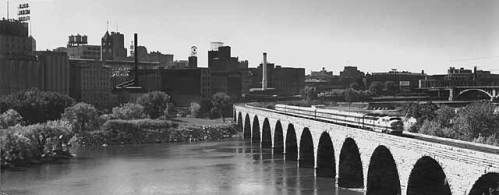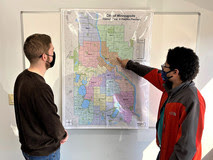Article by Michael Rainville, Jr.
 Lumber Exchange Building, 1886The Lumber Exchange Building, one of the last remaining structures of Minneapolis past that thankfully survived our city’s Urban Renewal era in the 1960s and 70s when so many of our beautiful buildings were torn down to make way for parking lots. The Lumber Exchange has stood tall for well over 100 years at Hennepin Avenue and Fifth Street, watching the ups and downs of this ever-changing metropolis.
Lumber Exchange Building, 1886The Lumber Exchange Building, one of the last remaining structures of Minneapolis past that thankfully survived our city’s Urban Renewal era in the 1960s and 70s when so many of our beautiful buildings were torn down to make way for parking lots. The Lumber Exchange has stood tall for well over 100 years at Hennepin Avenue and Fifth Street, watching the ups and downs of this ever-changing metropolis.
The lumber industry in Minnesota served as the catalyst for economic growth and prosperity during the first decades of statehood, and a dedicated space to conduct business and make deals was necessary for not just the continued success of the industry, but the growth of our westward-expanding nation. The decision to create a lumber exchange in Minneapolis came in 1885 with the architectural team of Franklin Long and Frederick Kees in charge of the design. This architect firm also created the Hennepin Center for the Arts, formally known as the Masonic Temple, the Flour Exchange Building, City Hall, and the original Minneapolis Central Library.
 Expansion under constructionWith construction starting in 1885 and ending in 1887, the original Lumber Exchange stood ten stories tall, was situated along South Fifth Street, and featured exceptional Richardsonian Romanesque architecture. This structure was a shadow of what the building looks like today. There were thirteen bays of windows spanning 142 feet along Fifth and just three bays of windows spanning about thirty-eight feet along Hennepin. Shortly after completion, Long and Kees were hired once again to expand the building. Staying true to the original building in terms of style and appearance, the expansion wrapped up in 1890 and extended the Hennepin side to sixteen bays of windows, covering 170 feet, and two additional floors were added, bringing the total to twelve.
Expansion under constructionWith construction starting in 1885 and ending in 1887, the original Lumber Exchange stood ten stories tall, was situated along South Fifth Street, and featured exceptional Richardsonian Romanesque architecture. This structure was a shadow of what the building looks like today. There were thirteen bays of windows spanning 142 feet along Fifth and just three bays of windows spanning about thirty-eight feet along Hennepin. Shortly after completion, Long and Kees were hired once again to expand the building. Staying true to the original building in terms of style and appearance, the expansion wrapped up in 1890 and extended the Hennepin side to sixteen bays of windows, covering 170 feet, and two additional floors were added, bringing the total to twelve.
Once the expansion was completed, the total cost of the building’s construction came to a total of $1,200,000, or over $35,000,000 after inflation. Using the historical definition of “skyscraper,” this was the city’s first, and it is still the oldest high-rise building in the city. Outside of New York City, the Lumber Exchange is the oldest building that is twelve or more stories in the entire United States, and it was known as one of the first completely fireproof buildings in the nation.
This last moniker was put to the test within a year of the building’s completion when a fire broke out at a neighboring paint and hardware store along Fifth Street during the winter of 1891. The original, more slender section of the Lumber Exchange was semi-fireproof, known as “slow-burning,” and the two-story addition on top, that was fully fireproofed, had yet to be furnished and was still under minor construction in order to incorporate it into the rest of the building. These factors lead to the fire next door spreading to the semi-fireproof parts of the Lumber Exchange. The blaze was controlled and extinguished, and to the surprise of many, there was minimal to no damage to the two-story addition.
 Aftermath of the fire, 1891
Aftermath of the fire, 1891
The Lumber Exchange served as a case study, the perfect example of why it’s important to completely fireproof new buildings as American downtowns began to expand upward. As part of the post-fire renovations, the entire Lumber Exchange was converted from semi-fireproof to completely fireproof, making it one of, if not the first, fireproof buildings in the country - quite an important feature for a lumber exchange if you ask me.
After the lumber industry slowed down in Minnesota, the building needed to find new tenets. Over the years various businesses have called the Lumber Exchange home, including a barber shop, bank, and many bars. In fact, the notorious Kid Cann used the barber shop as an alibi during the 1936 trial for the murder of New York Times journalist Walter Liggett where Cann was quickly acquitted. Over the years, the building has also been adorned with some interesting pieces from around the world. The basement features marble floors from an early twentieth century bathhouse in Turkey, and the 100-year-old brass revolving door that once connected Grand Central Station to the Commodore Hotel in New York City was brought to the Lumber Exchange in 1979 and now serves as the main Hennepin Avenue entrance. Because of its architecture, fireproofing technology, and importance to the lumber industry in the state and country, this building was included in the National Register of Historic Places in May of 1983.
 Current day Lumber Exchange Building. Photo: R2 Companies
Current day Lumber Exchange Building. Photo: R2 Companies
Today, the building is home to Trieste Café, The Pourhouse, The Exchange & Alibi Lounge, and the Lumber Exchange Event Center to name a few. I actually had the opportunity to step inside the building and Event Center this past Friday for the wedding of one of my friends and graduate school classmates, so if anyone asks about my whereabouts on Friday, October 29th between the hours of 4pm and midnight, that’s where I was. Nowhere else.
 Michael with girlfriend Theresa and the newlywed couple, Jessy and Eric, in the Lumber Exchange Event Center.
Michael with girlfriend Theresa and the newlywed couple, Jessy and Eric, in the Lumber Exchange Event Center.
For 136 years, the Lumber Exchange Building has stood the test of time, from fires to Urban Renewal. The next time you visit downtown, go to a sporting event, pick up a book from the library, or enjoy a night out at the many bars and restaurants, take a good look the historic Lumber Exchange as it peers over Hennepin Avenue, watching the city grow as it has for so long.
- - - - - - - - - - - - - - - - - - - - - - - - - - - - - - - - - - - - - - -
 About Michael Rainville, Jr.
About Michael Rainville, Jr.
A 6th generation Minneapolitan, Michael Rainville, Jr. received his B.A. in History, Graduate Certificate in Museum Studies, and M.A. in Art History from the University of St. Thomas.
Michael is a historical interpreter at the Minnesota History Center and has been a lead guide at Mobile Entertainment LLC, giving Segway, walking, and biking tours of the Minneapolis riverfront for 9+ years.
 Friday, November 5, 2021 at 2:16PM |
Friday, November 5, 2021 at 2:16PM |  Kim Eslinger |
Kim Eslinger |  Following an extensive clinical trial and final recommendations from CDC for the Pfizer COVID-19 vaccine for 5- to 11-year-olds, Gov. Tim Walz announced that Minnesota will begin vaccinating children this week.
Following an extensive clinical trial and final recommendations from CDC for the Pfizer COVID-19 vaccine for 5- to 11-year-olds, Gov. Tim Walz announced that Minnesota will begin vaccinating children this week.





































